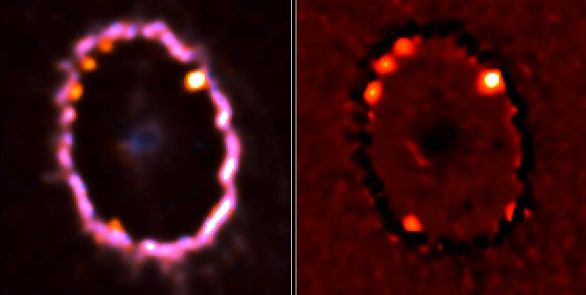
|
Credit & Copyright: P. Challis and R. Kirshner
(CfA),
P. Garnavich
(Univ. Notre Dame),
SINS
Collaboration,
NASA
Explanation:
In February of 1987, astronomers witnessed the brightest
supernova
of modern times -
supernova 1987A in the
Large Magellanic Cloud.
Mysterious rings of material
surrounding the
expanding stellar debris
were soon emitting a visible glow excited by intense
light from the explosion.
After fading over the intervening years, the interior ring
has just been seen to
sprout four new hotspots, as illustrated in
these two versions of a
Hubble Space Telescope image recorded
on February 2nd.
The abrupt appearance of the new features suggests that
matter from the stellar blast wave itself has begun to
slam into the ring in earnest, shock-heating the gas and producing
the bright hotspots.
The left-hand picture shows the glowing ring, initially excited
by light from the explosion, along with the
shocked hotspots.
The right-hand picture has been further computer enhanced
to emphasize the hotspots.
The brightest spot at the right
was first observed in 1997, while the
four spots on the left half of the ring are new.
Astronomers now eagerly anticipate a dramatic
rejuvenation
of the glowing ring as the bulk of the blast wave material,
traveling at about 60 million kilometers per hour,
continues to plow into it.
|
January February March April May June July August September October November December |
| ||||||||||||||||||||||||||||||||||||||||||||||||
NASA Web Site Statements, Warnings, and Disclaimers
NASA Official: Jay Norris. Specific rights apply.
A service of: LHEA at NASA / GSFC
& Michigan Tech. U.
Based on Astronomy Picture
Of the Day
Publications with keywords: SN 1987a - supernova remnant - supernova
Publications with words: SN 1987a - supernova remnant - supernova
See also:
- APOD: 2025 October 1 Á NGC 6960: The Witchs Broom Nebula
- APOD: 2025 July 31 Á Supernova 2025rbs in NGC 7331
- APOD: 2025 June 9 Á Between Scylla and Charybdis: A Double Cosmic Discovery
- Supernova Remnant Cassiopeia A
- APOD: 2025 January 8 Á Supernova Remnants Big and Small
- APOD: 2024 September 18 Á The Mermaid Nebula Supernova Remnant
- APOD: 2024 April 16 Á Filaments of the Vela Supernova Remnant
